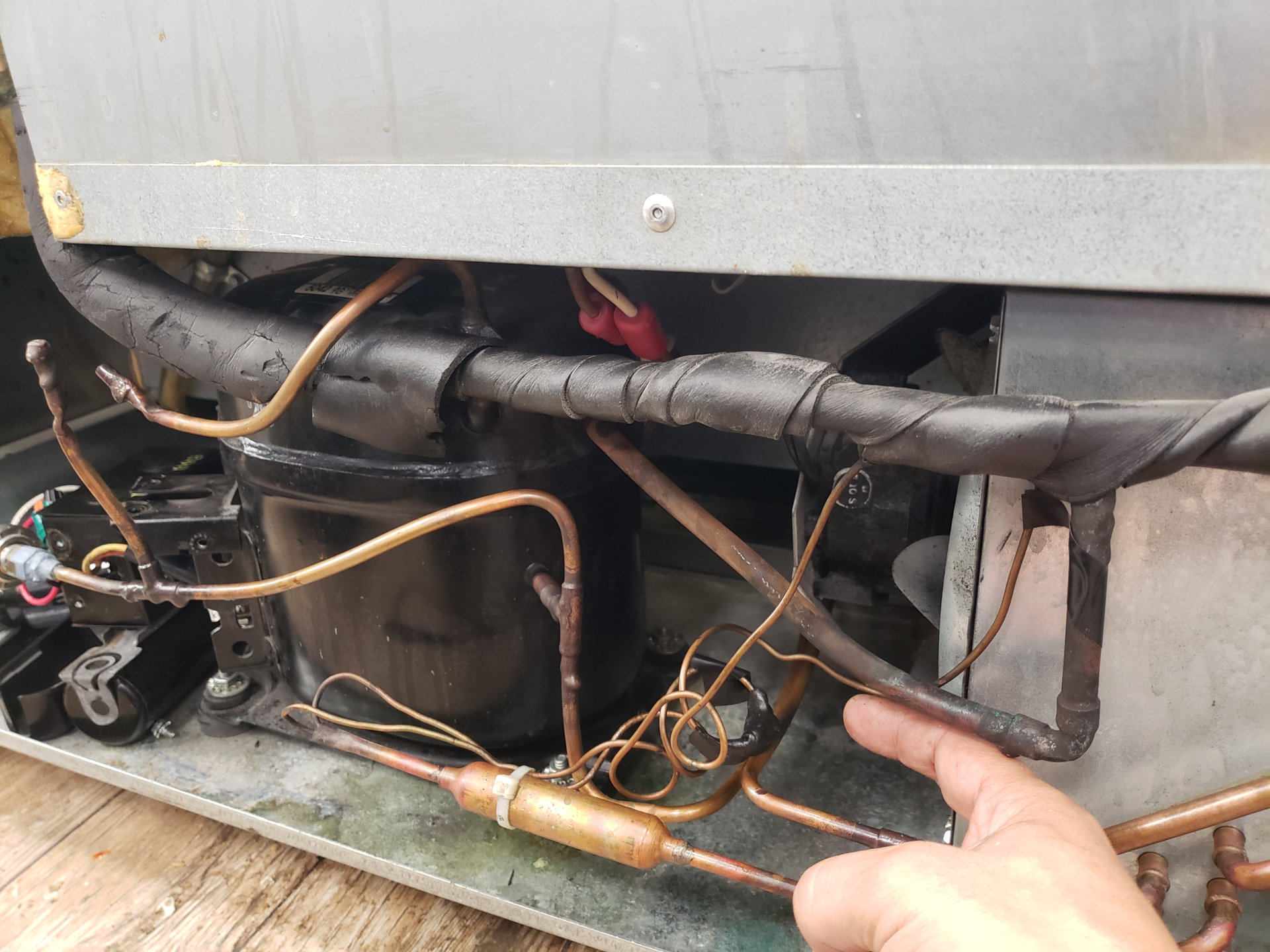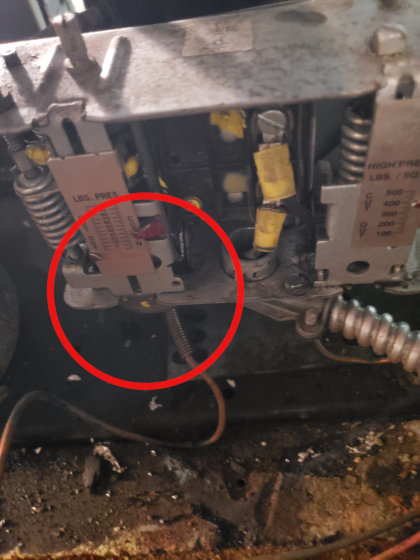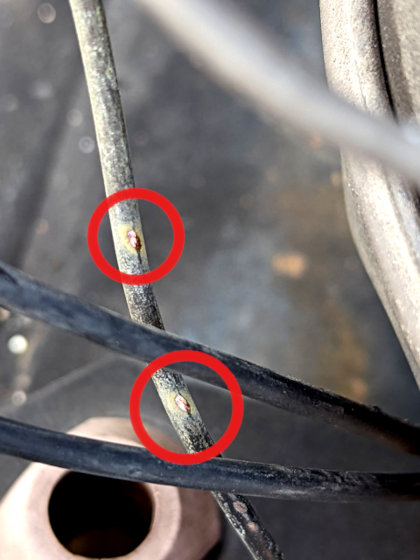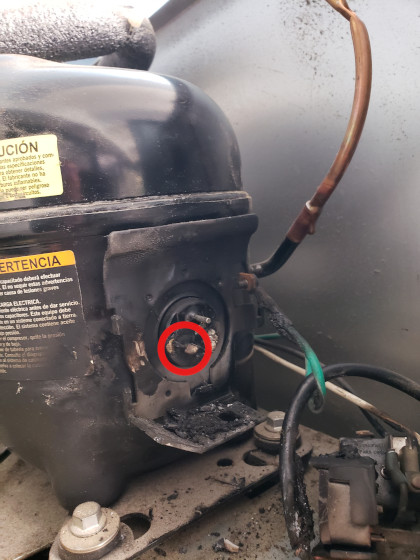Are you curious about Freon leaks?
Have you been misinformed that Freon R22 is illegal?
Do you want to know what causes a Freon leak, where your system can leak, and how to find out if it has?
Are you looking for ways to prevent your air conditioner from leaking?
If so, here we will answer all of these questions and more.

First, Refrigerant is the chemical compound used in cooling systems to reduce the temperature of a given space. It's important to note that "refrigerant" is the correct term to refer to this chemical compound - not "freon" or "gas".
The term “Freon” is actually a trademarked brand owned by the chemical company Chemours and is used to describe halocarbon products. Since "Freon" is a trademarked term, it should be only used to refer to refrigerants R-12, R-22, R-410A, R-502, and R-503. Generally speaking, these substances are nonflammable, low-toxicity liquids or gases, and can be found in air conditioners. Freons include CFCs and HCFCs, which are known polluting chemicals.
Governments around the world have taken action to reduce pollution namely protect the ozone layer and reduce global warming.
In the US, the Clean Air Act (CAA) put in place by the Environmental Protection Agency (EPA), developed a program to control many harmful substances. Manufacturers have been forced to phase out ozone-depleting ODP refrigerants and substances with high Global Warming Potential GWP. Due to the fact that these refrigerants harm the environment, the EPA mandates that only certified technicians who have passed the EPA 608 exam are allowed to handle refrigerants. Check epa.gov/section608.
Those who break the rules will face serious consequences, from civil fines to criminal prosecution. Furthermore, upon detection, as stated on the EPA website a freon leak must be repaired only by an EPA 608-certified technician.
Once refrigerants are firmly confined in a system, under normal conditions, they do NOT expire, their level does NOT diminish as such do not need to be replaced - unless there is:
- Freon leak
- Acid formation in the refrigerant, or
- Burned compressor.
Finding a refrigerant leak can be a real challenge! It's not like a water or gas leak, which is relatively easier to detect. Refrigerant leaks can be tricky to locate because they are so small pinholes also called micro-leaks. It takes a skilled technician to find and repair a refrigerant leak, so if you ever suspect there might be a refrigerant LEAK in your residence or business, make sure to call a professional right away.
Fixing Freon Leaks, Step by Step!
If you've ever had to repair a refrigerant leak, you would quickly know it's a complex process that requires a lot of steps. The cost can seem pretty high, but it's a tedious job that requires specialized and expensive tools. Finding and repairing a leak might take between 3 to 8 hours. Here's a breakdown of what the repair process looks like:
- Finding the leak: visually through oil traces or using a leak detector
- Confirming the leak with a soap bubble test see video
- Recover any leftover refrigerant from the system
- Pressurize the system with Inert gas (usually Nitrogen)
- Braze the leaking area
- Replace the filter drier (required each time the refrigeration system is opened)
- Pressurize the system with Nitrogen
- Conduct a pressure decay test
- Run a vacuum
- Break the vacuum
- Run a deep vacuum down to 500 microns or less
- Recharge the system with refrigerant
Video showing soap bubble "Freon" Leak
What's So Bad About Freon Leaks?
- No cooling System: When there is a refrigeration leak, the system will lose charge, which lowers the pressure on the evaporator and causes it to form solid phase ice on the evaporator fins. This ice build-up obstructs airflow pathways.
- Potential compressor burnout: As freon flows through the system, it carries compressor lubrication oil with it. When refrigerant leaks, it carries lubricating oil with it, thus reducing the amount of lubricant needed to cool the compressor. So after a freon refill, the amount of oil in the compressor will be less and less each time, leading it to run at a lower lubricant level which induces higher compressor running temperatures, kept unchecked, ultimately the compressor will slowly burn. To summarize, the end user might see the end result which is a burned compressor but in reality, the root cause of the burnout is the reduction in lubricating oil which escaped with the refrigerant Leak.
- Compressor overheating: The amount of freon charge is adjusted such that the recirculated freon on the suction line is at a temperature suitable for cooling the compressor. Again, the end user might see the end result as a compressor burnout. In reality, the root cause of burnout is lower than the required refrigerant level.
- Fire Risk: Some refrigerants such as, R290 (purified propane) or R600 (iso-butane) are flammable. Hold On! The adjective "flammable" is an understatement; "extremely flammable" is more appropriate. With these gases, there will be fire with as little as an electrical spark or a little flame. R290 and R600 are utilized in both home and business appliances.
- Serious Pollution Problem: It is well documented that a number of refrigerants have an extremely poor environmental record. R12, R134A, R404, R410A and R22, for example, have high ozone depletion potentials (ODP), which is the primary reason they are being phased out by EPA.
Top freon leaks detected locations
Freon leaks are a prevalent issue in air conditioning and refrigeration systems. It is critical to detect freon leaks early in order to minimize costly repairs, energy waste, and environmental damage. It is a key requirement for assuring the systems' proper and efficient operation. Here are some of the most likely spots for freon leaks to occur.
- Brazing Joints: Refrigerant lines are the only way for Freon to recirculate an Air Conditioner, walk-in box, or freezer. Brazing or soldering is required to complete and close the circuit of these lines. Leaks are notably common in brazed joints and connectors. Poor brazing during the manufacturing process or field installation, along with high refrigerant pressure and operational vibration, can result in pinholes at these joints, resulting in leaks in these lines. Poor brazing in refrigeration systems can be caused by a variety of issues.
- Refrigeration Valves (Access ports, Service ports, Schrader Valves, King valves): The valve connections in a refrigeration system are required to measure refrigerant pressure and add or recover refrigerant. However, leaks can occur at these connections. Shrader Valves: These look like tire pressure valves. Used as a service point for gauging system pressure or adding refrigerant to the system. Leaks at the Shrader valve might occur as a result of a manufacturing flaw, system aging, excessive heat during brazing, jamming, or a missing cap. Regular checks of the ports can help to reduce leaks greatly.
- Evaporator coils: Evaporator coils are heat exchangers designed to absorb heat from the environment. Excessive acids are the major cause of leaking evaporators in commercial refrigeration, such as a walk-in cooler or sandwich prep table. Physical damage (typically caused by humans or vibration), corrosion (rust), and aging are the most common causes of leaks in Air Conditioning evaporators. It is worth mentioning that coastal installations near saline environments appear to corrode faster than their counterparts.
- Rub Out / Rubout / Rubbout: It is the easiest leak potential to avoid, and here's why. It is the effect of vibration. It takes months or years to occur and then manifest; certainly, it does NOT happen overnight. As a result, it may be easily discovered at early stages during preventive maintenance and, most likely, managed before a rubout evolves into a leak. Once the leak happens, the repair will be much more extensive. Rub Outs consist of a short portion of piping rubbing against a) another piece of tubing, b) an electrical wire, or c) any system surface. Detecting and repairing a premature rubbout is your lowest-hanging fruit, yet it is frequently overlooked or ignored.
- Condensing Coils: A rugged heat exchanger with multiple pass tubing, fins, and brazing joints that are designed to withstand high refrigerant pressures. Micro Chanel condenser coils are known to leak in salty coastal regions, according to real-world data from various HVAC companies. Most condensing units are installed outside, where they are subjected to harsh outside conditions such as snow, rain, and dust, which all contribute to corrosion and, eventually, leaks. We have seen several unmaintained condensing units that amass sand and leaves in the bottom of the units that are left uncleaned, rust accumulates, and contributes to pinhole leaks. A thorough cleaning once a year will significantly help avoid leaks.
- Pressure Control Switch: If such a device is present in the system, our systemic diagnostic methodology inspects it first because PCS are known to leak. Unfortunately, even well-known brands and high-quality items yielded inconclusive outcomes. There is no getting around it; there is no preventive maintenance or early detection.
- Compressor: According to certain statistics, 40% of leaks are caused by compressors. The data we shared with HVAC specialists are displayed here in descending order. With many moving parts, a high-duty cycle, and running at high temperatures, the compressor is the heart of the refrigeration system. Although compressor leaks are uncommon, the most typical leaks we've seen occur at the compressor pinouts, which are usually preceded by a server wiring burnout and agitation of pins during wiring. Otherwise, compressors are hermetically sealed.
No So Cool Freon Leak Examples. Huh!
Pressure Control Switch Leak

Service call for Norlake Walk-In coolers. We discovered a pinhole leak at RANCO Pressure Control Switch using an ultrasonic leak detector. The leak was hidden from visible observation, but the detector quickly found it.
Electrical Wires Rub Out

Several vibration-dependent leaks (VDL) are avoidable and are caused by faulty installation and a lack of preventive maintenance; This is an example of crankcase heater wires rubbing on the capillary which takes years to develop.
Compressor Leaking Freon

A fully loaded unclean condenser overheated the compressor startup kit and wires on a hot and humid day. Overheating compromised compressor pins, resulting in microscopic pinhole leaks. The diagnostic was confirmed by an electronic leak detection followed by a soap bubble - compressor changeout was unavoidable. Annual condenser cleaning could have saved a professional-grade Trulsen Glass Door Fridge from going to the trash.
Freon Leak Types and Discovery Techniques
Because there are numerous forms of Freon leaks, identifying them can be challenging.
- Standing leaks (SLs): these leaks that can be detected while the unit is off. This shall include freezer evaporative coils warmed up by defrost. SL leaks, fortunately, are the most common of all. ,
- Pressure-dependent leaks (PDLs): these are leaks that can only be detected when the system is pressurized. Typically, Nitrogen is used to pressurize the low sides and high sides per manufacturer specifications and find leaks. PDLs should be conducted if no leaks are discovered by the SL test,
- Temperature-dependent leaks (TDLs): are leaks associated with the heat of expansion. TDL usually occurs from high ambient air, condenser blockage, or during defrosting,
- Vibration-dependent leaks (VDLs): The mechanical strain of motion, rotation, refrigerant flow, or valve actuation are all associated with VDL,
- Combination-dependent leaks (CDLs): are flaws that require two or more conditions in order to induce leakage. For example, temperature, vibration, and pressure cause the discharge manifold on a semi-hermetic compressor to expand and seep gas, and
- Cumulative micro-leaks are examples of these (CMLs) these are the cumulative sum of all little leaks that develop over time in general they are too small to detect. The total loss over many years of operation slightly reduces the initial gas charge. In practice, a system having many fittings, welds, seams, or gasket flanges; the greater the amount of CML.
Finding these leaks is art and science
Freon Leak Search Methods
Experts use different techniques to find freon leaks. As shown next, each technique has its own limitations. A combination of multiple techniques is sometimes required. Regardless of the method used, a confirmation with soap bubble test is always needed.
- Visual Oil Inspection: this is the easiest of all it just requires a trained technician.
- Electronic Leak Detectors: we like this method the most as it might find leaks that otherwise are not discovered.
- DYE: the HVAC experts community is split about this method, many use it to discover leaks and did not report any refrigerant issues after the fact. However, many HVAC experts argue against adding any chemicals to the refrigerant. There has not been strong evidence to suggest a side effect of using DYE. At our company we do not promote or use DYE, our advice to you is: If you have no option but to use DYE to find the leak, repair it then extract more years on your system then by all means do it.
Causes of Refrigerant Leak
- Corrosion
- Age (nothing lasts forever)
- Lack of Maintenance - You! Yeah You!
- Poor Quality Equipment (some recycled copper evaporators are known to leak more frequently)
- Component Failure (Even brand name Pressure Control Switches are known to frequently leak)
- Poor Installation
- You! (Operator poor handling and bending of piping systems during cleaning or routine work)
We strongly recommend calling a certified HVAC service company to repair a freon leak. It is NOT a DIY task. On certain occasions, local authorities will issue a very expansive citation for wrong freon handling and disposal.
Once the leak is found and repaired it is then ok to refill with Freon.
Are you wondering if it's illegal to recharge Freon R22?
The short answer is NO for residential and light commercial. Units with less than 50lbs of refrigerants.
The primary reason for the phase-out of R22 is its negative impact on the ozone layer. This is because the chlorine atoms in R22 react with ozone molecules, breaking them down and depleting the ozone layer. This depletion can have serious consequences, as the ozone layer helps protect us from harmful UV radiation. Without it, the Earth’s atmosphere would become much more dangerous for humans, plants, and animals.
Have you ever heard people say it’s illegal to use R22 in an existing home or commercial unit? Were you misled by an HVAC salesperson?
If so, don’t believe them! Do your research.
Many people were informed by some shady HVAC companies that R22 is illegal. It's a common marketing tactic for them to tell you that R22 is illegal, in order to sell you a new unit where they make the most money.
Good News, It’s actually perfectly legal to "top off" an existing system with R22. However, if your system is leaking, you should get it fixed before refilling it with R22.
The thing is, since the ban on making R22, it's become harder to find and it's become very expensive.
So, if you're trying to refill your air conditioner with R22, it's best to get help from a professional who can help you figure out the best and most cost-effective solution. Ideally, get 2 or 3 quotes. Even a small second opinion consulting fee from an independent person would save thousands.
It is important to note that EPA has 12 months rules on the Refrigerant Leakage Rate for certain systems. The allowance for leak repair is governed by the EPA see ref.
| Appliance Type | Leak Rate |
|---|---|
| Industrial process | 30% |
| Commercial | 20% |
| Comfort cooling | 10% |
| All other types | 10% |